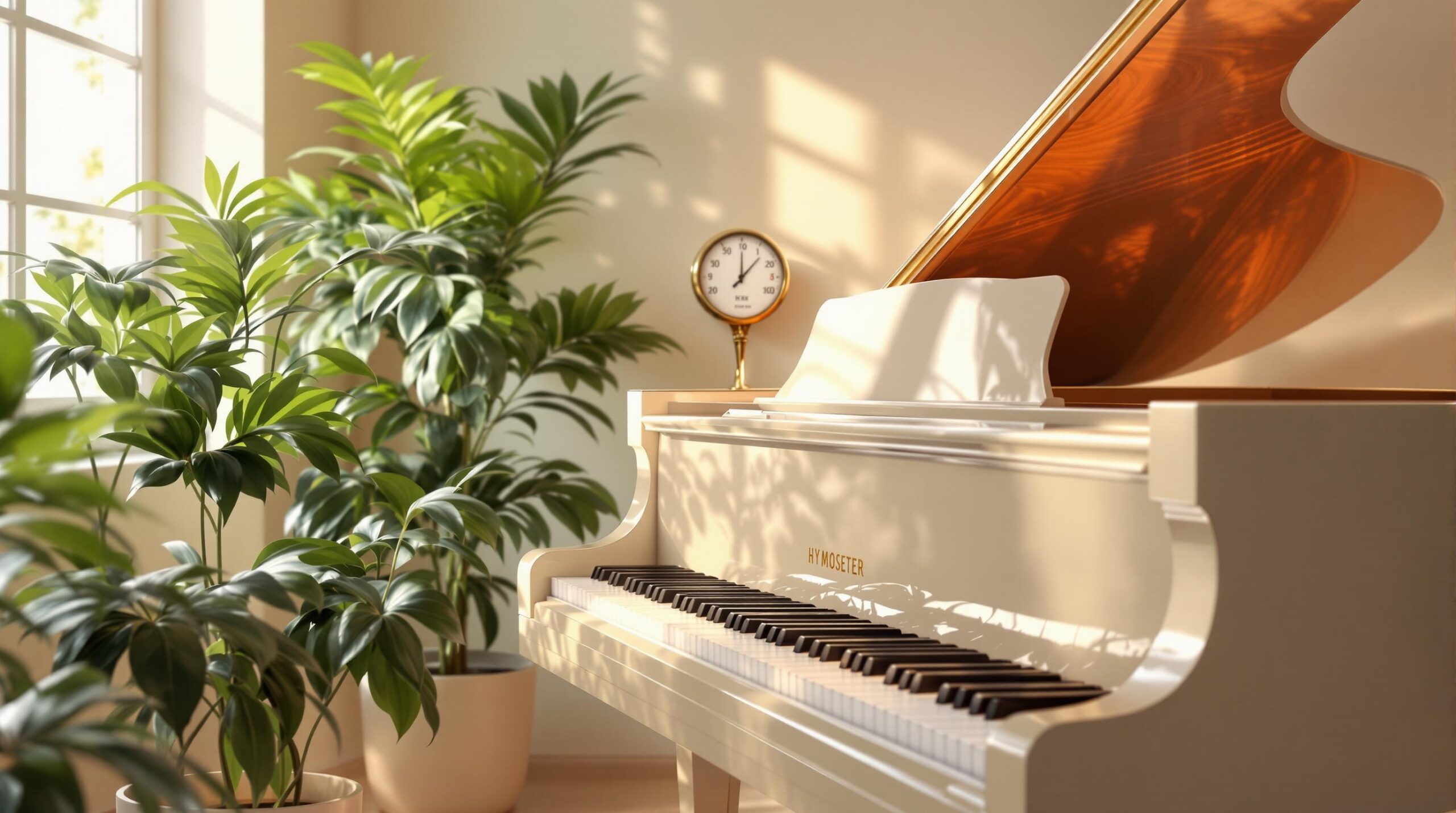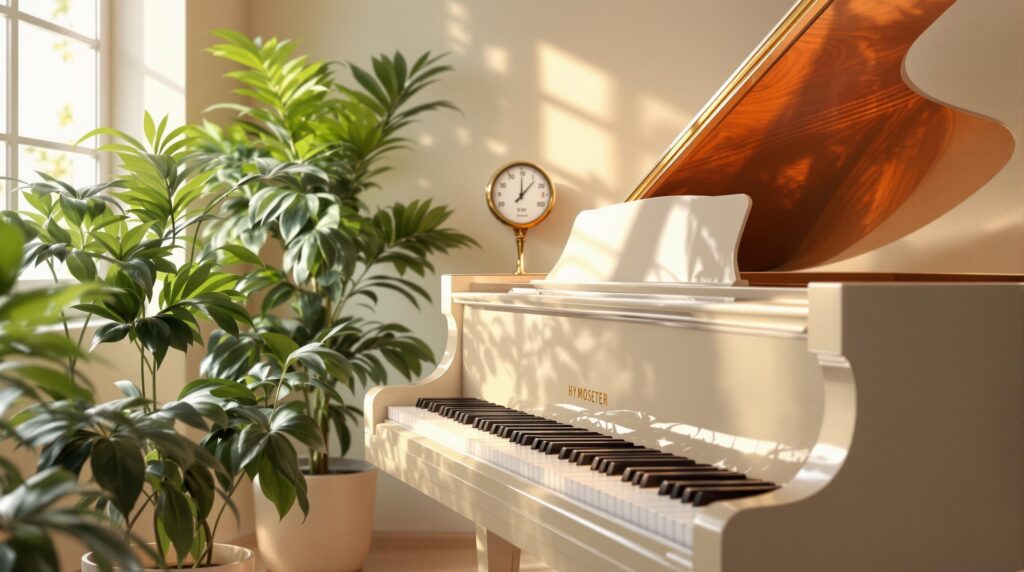
Humidity can make or break your piano. It affects tuning, sound quality, and even the wood’s structure. To protect your piano, keep humidity levels between 40%-60% year-round. Here’s what you need to know:
- Why It Matters: High humidity swells wood, while low humidity causes cracks and instability.
- What to Do: Use a hygrometer to monitor humidity. Adjust with a humidifier or dehumidifier as needed.
- Key Signs of Trouble: Sticky keys, uneven sound, or visible wood damage.
- Tools You Need: Digital hygrometers, room humidifiers, or piano-specific systems.
- Seasonal Care: Manage dry winter air with humidifiers and summer humidity with dehumidifiers.
Start by monitoring your piano’s environment and take action when levels stray outside the ideal range. Regular checks and the right tools can save you costly repairs later.
Piano Climate Control System Installation Process
Piano Humidity Basics
Humidity plays a big role in your piano’s health. Here’s what you need to know to keep it in top shape.
Best Humidity Levels
To keep your piano’s wood and mechanics in good condition, aim for a relative humidity of 40%-50%. Going outside this range can lead to tuning problems and changes in sound quality. Experts like those at Cooper Piano – a company with over a century of experience – highlight how crucial this range is for long-term piano care.
High vs. Low Humidity Damage
Humidity levels can affect your piano in very different ways. Here’s a quick breakdown:
| Humidity Condition | Effects on Piano | Potential Damage |
|---|---|---|
| High (Above 50%) | Wood swells, impacting action and keys | Misaligned keys and action; possible warping of the soundboard |
| Low (Below 40%) | Wood shrinks | Cracks in the soundboard; gaps that affect tuning stability |
| Fluctuating | Repeated expansion and contraction | Tuning instability; structural stress |
Pro Tip: Even a 10% rise in humidity can shift the pitch by about 1%, meaning you’ll need more frequent tuning [2].
Weather and Season Changes
Changing seasons can make humidity control tricky. In winter, heating systems dry out the air, which can lead to wood shrinkage and cracking. On the flip side, summer often brings high humidity, causing wood to swell. Spring and fall can be unpredictable, with fluctuating humidity levels creating extra challenges.
To keep your piano safe, consider investing in a piano-specific humidity control system. These systems work independently of your HVAC and help maintain stable conditions year-round.
Humidity Testing Tools
Keep your piano in top condition by monitoring its humidity levels with reliable tools. These devices fit easily into your piano care routine and help maintain the ideal environment for your instrument.
Hygrometer Selection
Choosing the right hygrometer is key to tracking humidity around your piano. Look for these features:
| Feature | Recommendation | Why It Matters |
|---|---|---|
| Accuracy | ±2% or better | Delivers precise readings within the optimal range (40%–60%) |
| Display Type | Digital LCD | Makes readings easy to see, even in low light |
| Response Time | Under 10 seconds | Quickly identifies changes in humidity |
| Calibration | Self-calibrating | Keeps readings reliable over time |
Where to Put Your Hygrometer
Placement matters for accurate readings. Follow these tips:
- Place it at the same height as the piano’s soundboard.
- Keep it 2–3 feet away from the instrument.
- Avoid direct sunlight, air vents, and windows.
- Ensure it’s in an area with good airflow.
For grand pianos, position the hygrometer near the strings but not directly under the lid. For upright pianos, place it on top of or next to the instrument, ensuring it’s not too close to the wall.
Reading Humidity Measurements
Understand what your readings mean and take action when necessary:
| Reading Range | Status | Suggested Action |
|---|---|---|
| Below 40% | Too Dry | Use a humidifier and check for drafts |
| 40–60% | Ideal | Maintain current conditions and monitor regularly |
| Above 60% | Too Humid | Use a dehumidifier and improve ventilation |
Take humidity readings twice a day to spot trends or sudden changes. If you notice large fluctuations, inspect your room’s ventilation and consider upgrading your humidity control measures. This proactive approach helps protect your piano from environmental damage.
sbb-itb-b8bc1ab
Humidity Control Methods
Once you’ve established a humidity monitoring routine, the next step is choosing a control method that works best for your room and piano. Keeping humidity levels stable requires dependable equipment and a clear plan.
Whole Room Solutions
Controlling humidity across an entire room creates a steady environment for your piano while also improving the overall space. According to a January 2023 study by the Piano Technicians Guild, pianos in controlled environments needed 30% fewer tunings compared to those in uncontrolled spaces [1].
| Solution Type | Recommended Room Size | Average Cost | Key Benefits |
|---|---|---|---|
| Console Humidifier | Up to 1,000 sq ft | $150–300 | Quiet operation, large tank |
| Portable Dehumidifier | 500–1,500 sq ft | $100–250 | Energy-efficient, easy upkeep |
| Whole-house System | 2,000+ sq ft | $400–500 | Full coverage, low monitoring |
Pick a device that matches your room size and use a hygrometer to keep an eye on humidity levels. Brands like Honeywell and Vornado are great for humidifiers, while Frigidaire and hOmeLabs are solid choices for dehumidifiers [2]. If managing the entire room isn’t possible, you can focus on piano-specific solutions.
Piano-Only Systems
For situations where room-wide control isn’t feasible, piano-specific systems provide direct humidity management. These systems maintain stable conditions around your piano, protecting it from damage caused by fluctuating humidity.
"Maintaining the right humidity is essential for preserving the quality and longevity of your piano", says John Smith from the Piano Technicians Guild [3].
For professional installation of these systems, reach out to Cooper Piano. Their certified technicians can help you find and set up the best option for your piano and its surroundings.
Regular Humidity Care
Checking and Adjusting
It’s important to keep an eye on your piano’s humidity levels to prevent damage. The ideal range is 40%-60%. If the levels stray too far, you risk issues like warping or cracking.
Use a digital hygrometer placed at the same height as your piano for accurate readings. Check the levels weekly, but during extreme weather or seasonal changes, bump it up to daily checks.
| Season | Monitoring Frequency | Common Issues | Recommended Action |
|---|---|---|---|
| Spring/Fall | 2–3 times weekly | Rapid fluctuations | Adjust settings gradually |
| Summer | Daily | High humidity spikes | Use a dehumidifier |
| Winter | Daily | Dry air from heating | Keep a humidifier running |
Now let’s dive into how to handle humidity care for each season.
Season-by-Season Care
Each season presents its own set of challenges for maintaining the right humidity levels. Here’s how to adjust your practices throughout the year:
Winter:
- Keep your humidifier filled and running consistently.
- Place the piano away from heating vents to avoid dry air exposure.
- Make checking humidity levels a daily habit.
Spring and Fall:
- Pay close attention during weather changes, as levels can fluctuate quickly.
- Adjust your humidity settings gradually to avoid stressing the piano.
- Be extra cautious during rainy periods.
Summer:
- Use a dehumidifier when needed to combat high humidity.
- Close windows during humid weather to prevent moisture buildup.
- Look out for sticky keys, a common sign of excessive humidity.
If you’re unsure or need assistance, Cooper Piano’s certified technicians are available to help. They specialize in humidity control, ensuring your piano stays in great shape and performs its best year-round.
Fixing Humidity Problems
Signs to Look Out For
Humidity issues can wreak havoc on your piano. Here are some common warning signs to keep an eye on:
- Sticky or sluggish keys
- Cracks or warped wooden parts
- Uneven key alignment
- Mold or mildew growth
- Frequent tuning problems or odd sounds
- Changes in touch response
- Inconsistent tone quality
Quick Fixes for Humidity Issues
If you notice humidity problems, take action right away:
- For high humidity: Use a dehumidifier to bring down the moisture levels in the room.
- For low humidity: A humidifier can help restore moisture gradually.
The ideal humidity range for your piano is between 40% and 60%. These steps can help protect your piano until a professional can take a closer look.
When to Call a Professional
If problems persist – like major cracks, severe warping, or continuous tuning issues – reach out to a skilled piano technician as soon as possible.
"Pianos are sensitive instruments that require careful humidity control to maintain their integrity and sound quality." – Cooper Piano
Cooper Piano’s certified technicians can handle more complex cases. Their services include:
- Installing advanced humidity control systems
- Repairing damaged parts
- Setting up regular maintenance plans
These solutions ensure your piano stays in top condition, even in challenging environments.
Conclusion
Key Takeaways
Keeping your piano in the right humidity range is essential for its longevity and sound quality. Aim for a humidity level between 40% and 60% to protect your instrument from damage. Using a reliable hygrometer to monitor levels regularly can save you from expensive repairs down the line.
Here’s how you can keep your piano in great shape:
- Monitor the room’s conditions consistently.
- Place your piano thoughtfully, avoiding windows and heating vents.
- Use the right tools, like humidifiers, dehumidifiers, or piano-specific systems.
- Schedule regular professional maintenance.
"Maintaining the right humidity levels is essential for the longevity of your piano. Regular monitoring and appropriate control measures can prevent costly repairs." – Blake Cooper, Owner, Cooper Piano
Steps to Get Started
To protect your piano and ensure it performs beautifully, follow these practical steps:
-
Check Your Current Setup
Take a close look at your piano’s environment. Invest in a quality hygrometer to measure humidity levels. Depending on your needs, you might use a room humidifier or dehumidifier – or even a piano-specific system for more precise control. -
Set Up a Monitoring Routine
Regularly check humidity levels, especially during seasonal changes. Keep a log of your readings to spot trends and address issues early. -
Work With a Professional
Partner with an experienced piano technician for routine maintenance and advice on humidity management. Their expertise ensures your piano stays in top condition.

